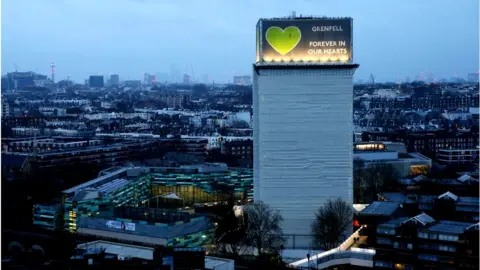Grenfell fire: Michael Gove says government guidance was a factor
 Getty Images
Getty ImagesBuilding regulations were "faulty and ambiguous" in the run-up to the Grenfell Tower fire, Housing Secretary Michael Gove has said - the first such admission by a government minister.
Mr Gove said there had been an "active willingness" on the part of developers to endanger lives for profit.
He blamed collective government failures "over many years".
The inquiry into the 2017 fire - in which 72 people died - has closed and is expected to report later this year.
On Monday, the housing secretary will announce a six-week deadline for developers to sign a government contract to fix their unsafe towers - or be banned from the market.
The government apologised in 2021 for its "past failures" in overseeing construction safety but said if regulations had been followed the fire could not have happened.
'Broken system'
Mr Gove appeared to contradict this position in a Sunday Times interview in which he said the regulations themselves contributed to unsafe practices in the industry.
Key government guidance failed to include cladding as a component which should have been subject to higher fire safety standards.
He said he believed guidance and regulation were "so faulty and ambiguous that it allowed unscrupulous people to exploit a broken system".
In a statement, survivors' support group Grenfell United said Mr Gove's admission was "what we've known all along", adding: "Government failed."
The statement continued: "Unless meaningful change follows, six years on, this admission will mean nothing more than empty words."
The issue of government regulation has been at the heart of who is to blame for Grenfell, and the consequent building safety crisis.
Architects and housing officials are under investigation following the 2017 fire, but it is now clear a crucial clause left "wriggle room" for unsafe materials to be used.
The concern centres on paragraph 12.7 of Approved Document B, the official guidance to ensure buildings are safe in fires.
At the time of the fire, this section said that on tall buildings above about five storeys any "insulation product" or "filler material" should be of "limited combustibility" - in other words unlikely to spread fire.
While insulation is used as part of a cladding system, this clause did not specifically include the cladding panels themselves, which typically cover the insulation and protect it from the rain.
 PA Media
PA MediaFollowing the fire, the government consistently argued that the words "filler material" did refer to cladding, because it is made of plastic "filler" sandwiched between two sheets of metal.
However, in a sign of official concern at the wording, the government first banned combustible cladding outright and then quietly changed the guidance to include a specific reference to cladding.
Now Mr Gove appears to have pre-empted a possible finding of the Grenfell Tower Inquiry, that the original guidance was faulty.
'Horrendous tragedy'
Before Grenfell, the guidance was widely interpreted as allowing architects and construction firms to add combustible cladding to high-rise blocks around England and Wales.
This led to a crisis in housing safety as building after building was identified as a potential fire risk, resulting in flat owners unable to sell, and facing large bills for the cladding to be removed.
Speaking to the BBC's Sunday with Laura Kuenssberg programme, Mr Gove said: "Nobody needs to tell me how desperately important it was to deal with all the issues that were provoked by the fire at Grenfell Tower.
"It was a horrendous tragedy. A tragedy for everyone involved, the people who lost their lives and people in that community but it also had ramifications that have gone on for years not been properly addressed."
He added that "significant process" had been made to make safe "the most dangerous buildings", those over 18m, but said "far too many" unsafe buildings still need remedial work.
'Sins of omission'
At a final hearing in November, inquiry lead counsel Richard Millett KC accused companies of a "merry-go-round of buck-passing" in order to protect their own interests.
The inquiry heard evidence that some of the companies involved in a 2015 refurbishment of the tower knew, or should have known, that the cladding being installed was flammable and not safe for use on tall buildings.
Mr Millett told the panel it should conclude "with confidence" that all 72 deaths resulting from the fire were "avoidable".
Mr Gove drew a distinction between "sins of omission and sins of commission", suggesting that, while the government was guilty of the former, some developers were guilty of the latter.
"There is an active willingness to put people in danger in order to make a profit, which to my mind is a significantly greater sin," he said.